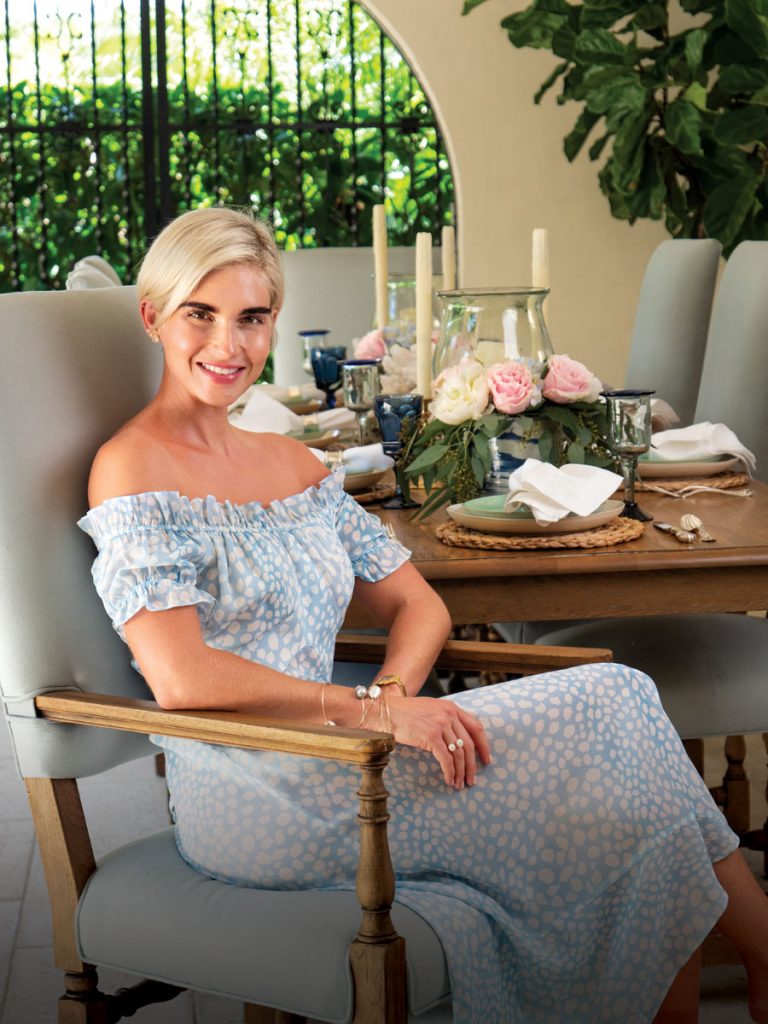
Ivey Leidy exudes wellness, complete with glowing skin, shiny hair, and the seemingly boundless energy required to manage a start-up holistic health business and chase after three young children. As a certified health coach and nutrition expert, Leidy leads a clean lifestyle, prioritizing a plant-forward diet that nourishes her from the inside out. But her journey toward well-being was a hard war fought: As a teen and young adult she battled anorexia and bulimia.
The West Palm Beach resident does not shy away from her past, but rather shares this history and her newfound relationship with food as a source of inspiration for friends and followers. On her blog, Living with Ivey, and corresponding Instagram account, she showcases her passion for simple, quality ingredients in colorful videos and posts. She illustrates, for example, the many ways to transform a humble avocado, lovingly slicing it into spirals or the shape of a rose and sprinkling it with seeds.

Her feed is full of culinary hacks and exercise circuits, but Leidy also dishes out advice, employing a breezy style that imparts just enough scientific evidence to entice readers into embracing whole foods and eliminating artificial ingredients without coming off as preachy. Her willingness to recount her struggles with anorexia and bulimia adds a personal touch to her mission to help others in their quests for optimal health. In a recent Instagram post, Leidy described her relationship to food as a marriage at which she constantly works. “I am the healthiest I’ve ever been,” she wrote, “but I have to put in the work to keep it that way.”
Eating disorders are nothing new, but they are on the rise, according to Johanna Kandel, founder and CEO of The Alliance for Eating Disorders Awareness in West Palm Beach. “It’s estimated that 30 million Americans will experience some sort of eating disorder in their lifetime; that’s 9 percent of the population,” she says.

What a lot of people may not realize is that there’s a growing consensus among researchers that up to 60 percent of the contributing factors that lead to eating disorders can be attributed to genetics. However, environmental triggers play a huge role as well. While media outlets have long bombarded audiences with relentless messages about body image, social media, which has grown exponentially in the last decade, has made matters even worse. “With social media in particular, people are constantly comparing their everyday lives to the highlight reel of someone else’s life,” Kandel adds. “But that one perfect photo may have been the result of 50 that were taken.”
 For Leidy, the pressure to look “good” meant that “the most important thing was eating as little as possible,” she says. The American Psychological Association (APA) notes that, beyond body-image issues, there are numerous situations that can precipitate eating disorders, such as traumatic events and dramatic changes in one’s status quo. Some individuals might turn to abnormal eating behaviors to regain a sense of control or, as the APA specifies, “to escape problems in their day-to-day lives.”
For Leidy, the pressure to look “good” meant that “the most important thing was eating as little as possible,” she says. The American Psychological Association (APA) notes that, beyond body-image issues, there are numerous situations that can precipitate eating disorders, such as traumatic events and dramatic changes in one’s status quo. Some individuals might turn to abnormal eating behaviors to regain a sense of control or, as the APA specifies, “to escape problems in their day-to-day lives.”
Leidy’s story begins on a Virginia farm, where she and her sister grew up. On the cusp of her teen years, her parents divorced. Her sister, who is four years older, was soon out of the house, and Leidy was left feeling alone amid the aftermath of the family’s breakup. That’s when her eating disorder took off. Initially, she was able to keep everything under the radar. “I got really good at hiding it, and it was easy to hide because my parents were distracted,” she recalls. “For me, it was all about control. I could focus on that and nothing else [including] my parents’ divorce.”
By the time she was an adult, her bulimia and anorexia had become a way of life. The impetus to finally take charge of her health came with the birth of her eldest son, Charlie. “I got so sick and tired of focusing on appearance,” she says. “I began to refocus on being healthy and to reprogram myself, if you will, toward health.”

In 2014, life took another major turn when she married Bobby Leidy, managing partner at Teneo Capital Management and the grandson of iconic fashion designer Lilly Pulitzer and Peter Pulitzer, a descendant of the newspaper magnate Joseph Pulitzer. The couple then added two more children, Bobby and Lilly, to their family.
Although the Pulitzer clan is synonymous with Palm Beach, Leidy confides that she wasn’t nervous about joining the famous family. While she never met Lilly Pulitzer, who died a few weeks before she came to know Bobby, she did have the opportunity to be around Peter Pulitzer, who passed away in 2018. “There was never anything pompous about them,” she says of the family. “Peter was a wonderful man—salt of the earth. But I do pinch myself a lot.”

Leidy was no longer anorexic or bulimic by the time she wed Bobby; however, she acknowledges that her eating habits were “disordered.” To help get a handle on the situation, she channeled her focus on food and wellness into furthering her education. After obtaining her health coach certification, she began counseling a small group of clients on the benefits of a personalized, holistic approach that integrates exercise, nutrition, and mental well-being. In addition to her one-on-one coaching business and website, she provides free information on Instagram, inviting followers to watch her exercise routines and prepare her simple, fresh recipes.
Malachy O’Hara Carron of Miami, a mother of three sons and owner of the interior design  company Royal Carron, discovered Leidy’s business while scrolling through Instagram. Already a disciple of clean, organic eating and regular exercise, O’Hara Carron says she was frustrated by the few stubborn pounds she couldn’t seem to shed. “My body just held onto weight. I had been looking for help for years and years.” She connected with Leidy by phone and was impressed with her personable approach. “She asked a lot of questions that really ran the gamut, from what I ate, my age, how many children I have, my blood type. I loved how detail-oriented she was.”
company Royal Carron, discovered Leidy’s business while scrolling through Instagram. Already a disciple of clean, organic eating and regular exercise, O’Hara Carron says she was frustrated by the few stubborn pounds she couldn’t seem to shed. “My body just held onto weight. I had been looking for help for years and years.” She connected with Leidy by phone and was impressed with her personable approach. “She asked a lot of questions that really ran the gamut, from what I ate, my age, how many children I have, my blood type. I loved how detail-oriented she was.”
She and Leidy designed a menu O’Hara Carron says she can live with forever. It includes lean animal protein, low-sugar fruits, healthy fats like avocado and nuts, and plenty of vegetables—and also leaves room for weekly tequila splurges. She doesn’t miss what’s lacking: processed foods, gluten, beans, grains, dairy, and nightshades, including tomatoes, eggplant, and bell peppers. After only four weeks under Leidy’s tutelage, O’Hara Carron witnessed a dramatic change. “I can’t believe how good I feel,” she says. “The bloating has gone down. My clothes fit better. I feel better.”

Sticking mostly to a plant-based diet herself, Leidy allows for flexibility in clients’ eating plans, though she cautions that there are some definite no-no’s. Whole foods are best, and the fewer additives the better. Read labels, she says, “and if the brain doesn’t recognize it, your gut won’t.” Promoting healthy gut bacteria is at the core of physical well-being, and processed food can upset the balance. “A lot of chronic disease in this country can be fixed with proper gut health.”
 Counseling adults who are ready to embrace change is one thing, but setting the foundation for beneficial eating habits in children is another matter. Nevertheless, it’s worth the effort, especially considering the high rate of childhood obesity and diabetes in this country. Packaged foods, which have become increasingly prevalent in the diets of American children, tend to be full of high-fructose corn syrup, the ubiquitous additive fueling a national surge in sugar consumption.
Counseling adults who are ready to embrace change is one thing, but setting the foundation for beneficial eating habits in children is another matter. Nevertheless, it’s worth the effort, especially considering the high rate of childhood obesity and diabetes in this country. Packaged foods, which have become increasingly prevalent in the diets of American children, tend to be full of high-fructose corn syrup, the ubiquitous additive fueling a national surge in sugar consumption.
Up to the age of 4 or 5, Leidy says, children typically eat what you give them. “Then they go to school,” she concedes with a laugh, where they can be exposed to all sorts of less-than-optimal choices. “I try not to deprive them.”
In her own home, Leidy is not overly strict but does make an effort to incorporate lots of veggies onto her children’s plates. “I try to get a lot of greens in them through trickery,” she reveals. She sneaks veggies such as grated carrots and spinach into pasta sauces; a favorite is pasta with kale, arugula, and spinach pesto. Another kid-approved creation are her smoothies, which include “all sorts of things, like flax, chia, spinach, and kale.”
Leidy believes in involving her children in meal preparation in order to pique their interest in healthy foods. “If they can get in the kitchen with me and get their hands messy, they are more likely to eat it because they’ve helped make it.” Together, they blend smoothies, dip strawberries in her homemade chocolate sauce, and use their own “kid-friendly” knives to cut up cucumbers and tomatoes.

With the knowledge that her daughter in particular will one day be exposed to excessive body-image scrutiny, Leidy is working to reinforce a positive attitude early. “I’m very conscious about not commenting on my own appearance, whether positive or negative,” she says. “I just don’t want to put any emphasis on that at all. Of course, my little girl loves to dress up and look at herself in the mirror, and I tell her she’s beautiful, but I try not to make appearance an important issue, and we never comment on other people’s appearances. Instead, I try to focus on praising them for how strong they are and how well they perform in sports or other activities.” She also scrupulously avoids conveying negative connotations about eating. “I don’t think shame should ever be associated with food.”
Regular exercise plays a big part in overall health—both mental and physical—and Leidy,  an avid runner, is an enthusiastic proponent. She takes Sundays off from a formal exercise program, but on the other six days she tries to squeeze in 30 minutes of cardio and an hour of strength training. While not everyone has extensive equipment at home, she stresses that it’s not necessary. “I’ve used laundry detergent bottles as weights, which are about 6 pounds each, and I’ve even used wine bottles as hand weights because they weigh about 3 pounds,” she says.
an avid runner, is an enthusiastic proponent. She takes Sundays off from a formal exercise program, but on the other six days she tries to squeeze in 30 minutes of cardio and an hour of strength training. While not everyone has extensive equipment at home, she stresses that it’s not necessary. “I’ve used laundry detergent bottles as weights, which are about 6 pounds each, and I’ve even used wine bottles as hand weights because they weigh about 3 pounds,” she says.
Given her long wellness journey, Leidy says she no longer holds herself to impossible standards and has come to terms with her appearance. She understands that without a healthy body, her goals would be unachievable. “It took me a while to love my body and what it’s done for me,” she says. “It’s produced three children, and I treat it as a machine that wants to work at the optimal performance level. You wouldn’t put cheap gas in a nice car. You have to take care of it.”










Facebook Comments